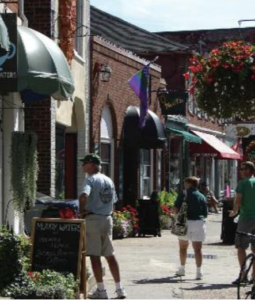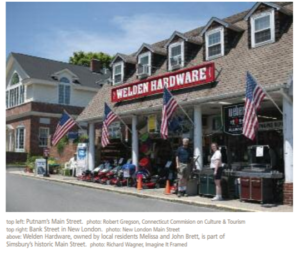by John Simone
(c) Connecticut Explored Inc. FALL 2010
Subscribe/Buy the Issue!
A few years ago, my wife and I visited a number of Tuscan hill towns in Italy. I was struck by how the people carried on their daily lives in centuries-old historic town centers.
 As we watched store owners each morning sweep their sidewalks and residents attend to the homes that have protected and nurtured countless generations, I said to my wife that I bet the Italian translation for “historic preservation” is “maintenance.” In Tuscany historic preservation is not some fad or movement as it is in this country; it’s a way of life.
As we watched store owners each morning sweep their sidewalks and residents attend to the homes that have protected and nurtured countless generations, I said to my wife that I bet the Italian translation for “historic preservation” is “maintenance.” In Tuscany historic preservation is not some fad or movement as it is in this country; it’s a way of life.
Here in America, our forefathers built our town centers right, and in many cases they built them to last. The difference between Tuscany and the U.S. has been that, since the advent of our highway system, an era of cheap gas, our love affair with the car, and availability of cheap land, Americans chose to leave their historic town centers to move to newly minted suburbs and beyond. In most cases the exodus from living close to our central business districts meant the loss of businesses and economic vitality there. The good news is that in many cities the infrastructure of compact buildings set in a very walkable neighborhood is largely intact and ready to be redeveloped.
The bad news is that more than 60 years of detrimental policy and benign neglect have left most of our town centers hurting. Reviving these under-utilized, and sometimes abandoned, central business districts can admittedly be a complex and time-consuming process. At Connecticut Main Street Center, the only statewide non-profit organization dedicated to providing comprehensive technical assistance for downtown revitalization, we understand the process. We help bring together public officials, business owners, financial resources, community activists, economic development professionals, and historic preservationists to create powerful partnerships.
Refocusing economic development activities on our historic downtowns positions us well to accommodate the growing number of people who want to live in walkable mixed-use districts. Empty nesters want walking access to services and shopping, and young professionals put a premium on the networks and connections that exist in compact, diverse, and dynamic neighborhoods. Restoring Connecticut’s historic downtowns and buildings creates jobs, brings vacant buildings back on the tax rolls, and adds value and vitality to neighborhoods. It also sets us apart from every other look-alike subdivision in America. Reusing our historic buildings is the ultimate form of recycling. Often the greenest building is the one already built.
As architecture and history expert Wayne Curtis wrote in Preservation magazine (January/February 2008), federal data show that a typical commercial building built before 1920 uses only about a half a percent more energy than a supposedly energy efficient building built after 2000. And, when we opt not to tear down an existing building, we save a tremendous amount of energy by not having to create and transport the materials for a new building.
The storefronts in our town centers mostly house locally owned businesses. Locally owned businesses keep their profits in the community in which their proprietors live and work. National chains’ profits go back to their headquarters and ultimately to their stockholders. Local businesses reflect the character of their community through unique products and services, helping to differentiate our town centers from malls filled with homogenous and ubiquitous chains. Our downtowns, even today, are prominent employment centers and great incubators for entrepreneurs.
A new concept called “place-based” planning— an approach that integrates issues such as housing, land use, transportation, and education rather than focusing separately on each issue—is gaining popularity. In a White House memo (August 11, 2009) from the Office of Management and Budget, Domestic Policy Council, Office of Urban Affairs, and the National Economic Council to the heads of all executive departments and agencies, the Obama administration called for improving and/or adopting place-based strategies to increase the impact of government dollars and to create more sustainable communities for generations to come. The memo states that the population of the United States is expected to grow by nearly 140 million people by 2050. This will require 200 billion square feet of new housing, business, and retail space. What this memo doesn’t address is that many of these needed billions of square feet of space already exist in our historic downtowns.
As we look ahead to how we will accommodate the projected growth in this country over the next 30 years, it is clear that development needs to happen in a compact way that will reduce sprawl, lessen our reliance on foreign energy, and shorten our commute time. Our historic town centers are perfectly situated to accommodate this growth. By finding new uses for vacant buildings and infill development (the reuse or repositioning of under-utilized or vacant buildings or sites within an otherwise developed area) in our downtowns, there is the potential to develop millions of square feet of space for people to live and work right here in Connecticut without bulldozing one tree or tearing up one field.
 Bringing our historic downtowns back to life must be at the center of any placed-based growth strategy. Here in Connecticut we still have the good bones of these compact, mixed-use quality places intact. Our economic development professionals, planners, and policy makers all need to take a trip to Tuscany to see that place-based planning is not a new idea; it’s just a lost art form that has been around for more than 5,000 years. Luckily it looks as though we are beginning to rediscover the sustainable benefits of re-building our historic town centers.
Bringing our historic downtowns back to life must be at the center of any placed-based growth strategy. Here in Connecticut we still have the good bones of these compact, mixed-use quality places intact. Our economic development professionals, planners, and policy makers all need to take a trip to Tuscany to see that place-based planning is not a new idea; it’s just a lost art form that has been around for more than 5,000 years. Luckily it looks as though we are beginning to rediscover the sustainable benefits of re-building our historic town centers.
John Simone is president and CEO of Connecticut Main Street Center.
